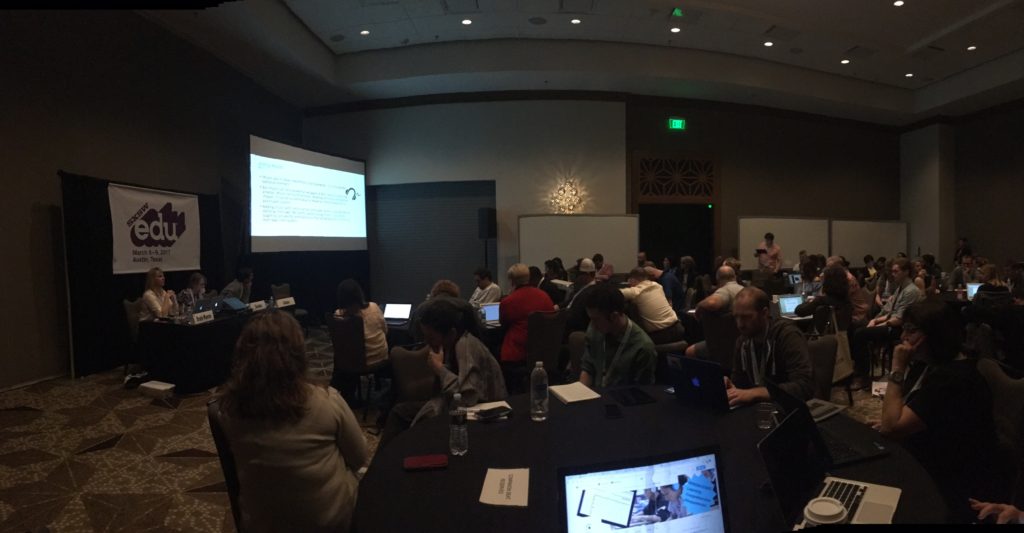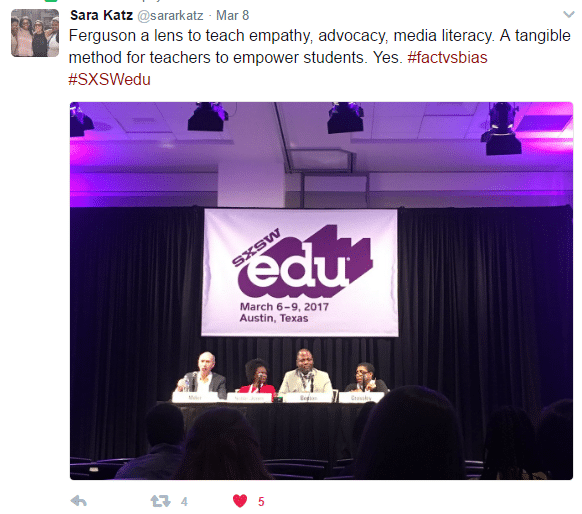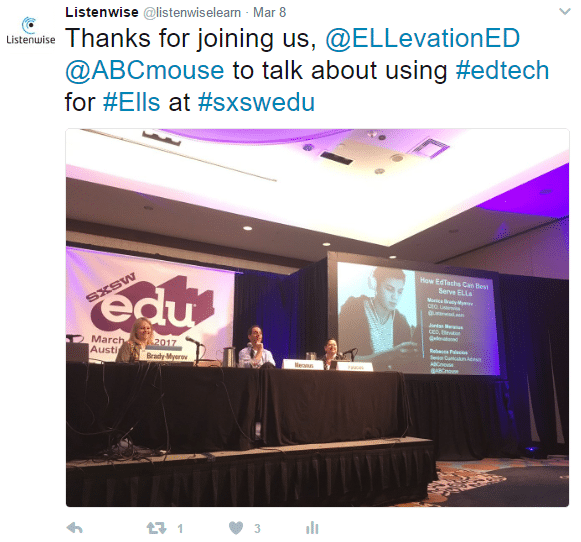This was my first time in SXSWedu, and I had a great time in Austin. It was such a fun atmosphere, and I left with information overload—in the best way. I had a great time connecting with educators on twitter, making a podcast with a new friend I met, and engaging in hands-on creative team-building activities.
Some standout sessions I attended:
“Teaching Storytelling for Empathy and Engagement”
 Presented by Micaela Blei of The Moth podcast.
Presented by Micaela Blei of The Moth podcast.
Telling stories allows teachers to bring themselves into the classroom in an authentic way. Micaela was a brilliant speaker. She started out with her own story to draw in the participants and then went on to dissect the elements of her story and talked about what makes a good story. She helped educators think about how they can bring stories into their classroom with best practices, tips, and tricks.
“If you are telling a story about what matters to you – people will be right there with you.” -Micaela
What makes a good story?
- Change – growth or change of some sort
- Theme – keeping to the plan, having a focus, knowing what to say and what is too much to say
- Being real – choosing something you can honestly talk about.
“Podcasts Lead to Deeper Understanding”
Presented by Monica Brady-Myerov of Listenwise, Emily Donahue of KUT, and Michael Godsey, a teacher and author
 Of course I’m a little biased, because Listenwise helped lead this workshop, but I enjoyed hearing three different perspectives that showed educators how to incorporate audio within the classroom in manageable steps. Monica began with the research behind auditory learning, Michael jumped in with how using and creating podcasts has been rewarding and challenging for his students, and Emily explored the best practices and tips for creating stories.
Of course I’m a little biased, because Listenwise helped lead this workshop, but I enjoyed hearing three different perspectives that showed educators how to incorporate audio within the classroom in manageable steps. Monica began with the research behind auditory learning, Michael jumped in with how using and creating podcasts has been rewarding and challenging for his students, and Emily explored the best practices and tips for creating stories.
“For radio, for audio, the most powerful way to tell a story is with other people’s voices.” -Emily
“Ask open ended questions to get people to open up. Who, what, when, why, and how. Ask people about their emotions.” -Emily
And the first steps to think about are:
- What is the story you want to tell?
- Who do you need to speak with?
- After speaking with them, what conclusion did you draw?
I even got to try out creating a podcast by using my iphone voice memo feature to record, and then I edited the audio in a free tool called Soundtrap. (Audacity is also another free option for editing.) To share the audio, I could upload the finished product on Soundcloud after sharing with my class/community.
“Facing Ferguson: A News Literacy Case Study”
Panel by: Steve Becton of Facing History and Ourselves, Callie Crossley of WGBH, Alan Miller, President & CEO of the News Literacy Project, and Brittany Noble-Jones, co-anchor of News Channel 12.
 This panel session was very powerful and full of really good information. The panel discussed how the fatal police shooting of Michael Brown in 2014 ignited national debates about race, policing, and justice and what it has done for our news and media reporting. It was extremely powerful to hear Brittany Noble-Jones who was one of the first reporters on the scene of the death of Michael Brown in Ferguson, Missouri.
This panel session was very powerful and full of really good information. The panel discussed how the fatal police shooting of Michael Brown in 2014 ignited national debates about race, policing, and justice and what it has done for our news and media reporting. It was extremely powerful to hear Brittany Noble-Jones who was one of the first reporters on the scene of the death of Michael Brown in Ferguson, Missouri.
Steve Becton had some very insightful thoughts about teaching news within your classrooms: “Students are not only great consumers of news, they are unofficial producers of news, because of the opportunities of social media. They know quite a bit about what is going on. The challenge that educators have is, “How do we bring news media into a learning environment so that kids can walk away with real skills?”
The panel discussed the new role of social media and with technology and internet, news now travels a lot faster than it has in the past. The panel dissected fact vs. bias and how all news is not created equal, and how we navigate falsities that spread fast across the media.
I walked away with so much to think about. How do we humanize people in the news? How do we walk in other people’s shoes- to develop empathy? How does doing this inform student civic participation?
Check out more on twitter at: #factsvsbias
“How to Best Serve ELLs with Edtech”
Panel by: Monica Brady-Myerov, Jordan Meranus of Ellevation, and Becky Palacios of ABCmouse
 This was another great discussion, and a great way to end the conference. The overarching theme of the panel was stated by Jordan Meranus of Ellevation: “What English learners need is what all students need.”
This was another great discussion, and a great way to end the conference. The overarching theme of the panel was stated by Jordan Meranus of Ellevation: “What English learners need is what all students need.”
The audience was heavily engaged as the panel discussed the ELL population growth and expected trajectory, how edtech can be situated to support this growing population, why there aren’t more edtech companies specifically focused on ELLs, and what administrators and school leaders need to embrace, among many other questions.
Questions from the audience centered around what educators can do now with technology, and what we want to see happening in the future with edtech. One poignant question from the audience asked: “Years from now what would you like to see edtech doing for ELL students and teachers?”
The panel response was very much in agreement that they don’t want to see a segmented population of ELLs and non ELLs, and would love to see more integrated solutions for the whole classroom. Along with edtech tools developed for all teachers at elementary, middle and high school levels to deliver content at the level they need. Lastly, a key point was that there should be more focus on empowering our English language learners in the U.S. to be global thinkers and feel pride in being multilingual. Everyone, teachers and students, should be advocates for multilingualism and a multicultural and multilingual society.
——————–
Thanks to awesome co-presenters we collaborated with: Teacher Mike Godsey and Emily Donahue from KUT on a podcasting workshop, Jordan Meranus from Ellevation, and Becky Palacios from ABCmouse and Colorin Colorado.
Find more content on twitter: @chelsmurph or @listenwiselearn or #sxswedu
For more pictures of the conference I’ve posted them on our Listenwise Facebook page.
